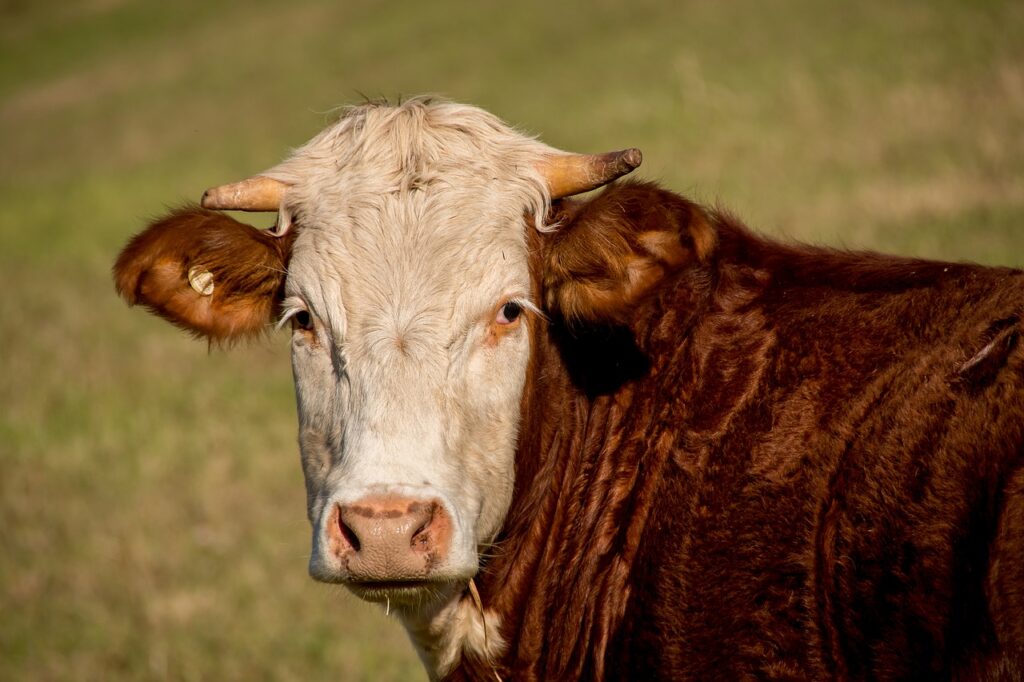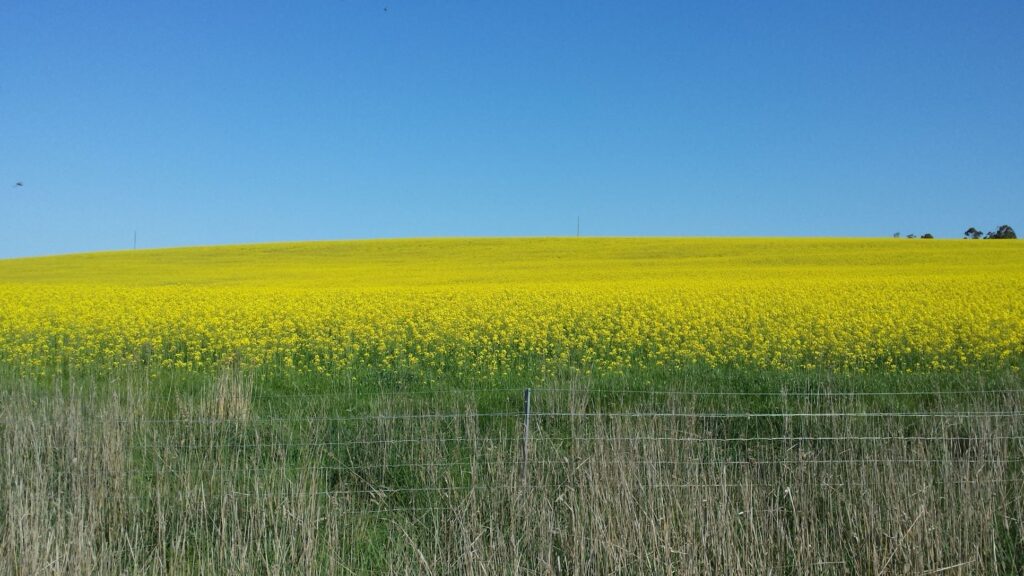Learn English while learning about daily life in Australia, with Rob McCormack
Podcast Number 132 – Australian Agriculture
(This podcast is 12 minutes and 50 seconds long.)
Hi,
Australia is a nation with a large land area and we use much of it to grow things. We grow food products such as beef, wheat or sugar, or we grow other products such as cotton and wool. This industry is called agriculture. In this podcast, I would like to tell you a little about Australia’s agriculture industry and how important it is to our economy.
There are five major groupings of agricultural products in Australia. The first is livestock, which covers farm animals grown for food and for other non-food products such as wool and leather. The second grouping is crops which includes examples such as wheat, barley, beans, canola, sugar cane and grapes. Crops are grown on a large scale, covering large areas of land. The third grouping is horticulture, which includes fruits and nuts, vegetables, flowers and nursery plants. Horticultural products are usually grown in gardens and generally require more constant attention by the growers compared to crops. The fourth grouping is forestry, meaning growing trees for wood. Finally, there is fisheries, which of course relates to fish.
All up, in 2019/20, Australia produced $67 billion worth of agricultural products. Our biggest agricultural product was beef from cattle, which was 20% of that total. Sheep and lambs for meat were 8%, as was wheat 8% and fruit and nuts 8%. Vegetables were next at 7% along with milk, also at 7%. Wool production made up 5%, followed by all other products with smaller percentages.
Around 55% of Australia’s land is used for agricultural production. Cropping and horticulture happens in areas closer to the coast, where rainfall is more reliable. This is also true for livestock production, although large areas of Australia’s drier outback are also used for livestock grazing of the native vegetation. These parts of Australia have much less reliable rainfall so the number of livestock per square kilometre is much lower. In order to make these farming properties worthwhile, they must be very, very large indeed. Such large cattle and sheep farms in Australia are called cattle stations or sheep stations (these are referred to as ranches in the United States). For example, the largest cattle station in Australia is the Anna Creek Station in South Australia, which is 23,677 square kilometres in area and can support up to 17,000 cattle (that’s less than 1 animal per square kilometre). Mustering or rounding up the cattle on Australian cattle stations these days is done by helicopters together with motorcycles and trucks, as well as the traditional method of using horses.
In Podcast 54 (https://slowenglish.info/podcast-54-what-australians-eat/), I talked about the wonderful selection of fresh foods which you can buy in supermarkets in Australia. Australians take it for granted that such a great selection of foods is always available and relatively cheap, depending on the season. Of course, it takes a large and well-run industry to produce and deliver such a variety of food. In fact, in Australia we produce much more food than we need for our own population, which means we can export around 70% (by dollar value) of our agricultural production to other countries. In a real sense, we can say we help to feed the world.
It is not only in the supermarket that I can see the results of our agriculture industry. When I am out riding my motorcycle in country Victoria, I like to take the back roads where I get to ride past many of the farms which produce these products. This includes cattle farms and sheep farms. I always see healthy animals with plenty of feed and space to move. No wonder the quality of the product is always good. There are other areas where I pass by large fields of cultivated vegetables or strawberries. In some areas of Victoria the soil is wonderfully rich and is perfect for growing berries or vegetables. I am always impressed how well organised and well-kept the long, long rows of vegetables are. Near a town about 40 km from Melbourne I pass through a large set of cultivated fields where strawberries are being grown. I buy strawberries every week when they are in season and I often wonder if the strawberries I buy come from this farm. I also ride through large areas of vineyards growing grapes for wine. Just like the vegetable and berry gardens, the long carefully groomed lines of grape vines are a sight to see. (See Podcast 118 https://slowenglish.info/podcast-118-australian-wines/)
Sheep farming for wool has a long history in Australia and was the first large scale agricultural industry established after European settlement. It is an interesting story and deserves its own podcast which I will do in the future. Wool is less dominant in Australian agriculture nowadays, although Australia still produces around 25% of all the raw wool in the world. In fact, in 2016/17, around 74 million sheep were shorn in Australia. That’s a lot of wool!
Another interesting Australian agricultural product is sugar cane. We export around 86% of our sugar cane crop. My wife and I took a holiday to Cairns in tropical north Queensland in 2019 and we were amazed at the size of the farms growing sugar cane there. The site of large fields of tall sugar cane plants is quite striking. It is a highly mechanized industry and Australian sugar cane farmers are very efficient. While in Cairns, we also discovered the wonderful taste of freshly squeezed sugar cane juice. That is a real treat and I can highly recommend it.

Sugar cane field in Queensland.
Image by Axelle Spencer from Pixabay
Our farmers are very efficient and receive relatively little support from the government in the form of subsidies. According to the OECD in 2020, the Australian government provides around 2% of farmer’s income as subsidies. This compares to a world average of around 18%. European Union countries, for example, subsidize their farmers around 18% of their income and the United States subsidize their farmers around 10%. These numbers show that Australian farmers must be very efficient in the way they run their farms. Even with these low subsidies, they can still compete very successfully on world markets for agricultural products. I hope that Australia can continue to be a major producer of such products into the future, although the looming effects from climate change will be a challenge we must manage.
If you have a question or a comment to make, please leave it in the comments box at the bottom of this page. Or, you can send me an email at rob@slowenglish.info. I would love to hear from you. Tell me where you live, a little bit about yourself and what you think of my Slow English podcast. I will write back to you, in English of course. If you would like to take a short quiz to see if you have understood this podcast, you will also find it on my website. Goodbye until next time.
Rob
Podcast 132 Quiz - Did you understand the podcast?
You can take the quiz as many times as you like.
Vocabulary
according to = when someone else or an organisation gives information
amazed = when you like something, or when you are surprised by something
billion = 1,000 million
cattle = a general term to describe cows, bulls, steers and calves
challenge = something which is hard to do
compete = to be in a contest with others
constant attention = when regular care is given
covering = (here) when you put something over something else
cultivated = grown in a garden
deliver = to bring things to the customer
deserves = (here) needs
dominant = to be the strongest, the leader
drier outback = that part of Australia far from the cities where there is little rain
economy = describes all the goods, services and jobs in a country, including the money paid
efficient = done with the least waste and the least cost, while keeping quality high
established = started, began
European settlement = when Europeans came to live in Australia
export = to sell something to another country
feed = food for livestock
grazing = when livestock eat the plants on the ground
groomed = trimmed or cut to make sure they grow well
groupings = when things are put together because they are the same or similar
income = the money you earn in your job or business
industry = a group of people and businesses which make and sell products or services
lambs = young sheep
leather = the skin of a cow which is made into shoes, belts or other items
looming = is coming in the future and will be important
manage = to run, to operate, to look after
mechanized = uses machines, not by hand
mustering = the process of bringing livestock together in one place
native vegetation = plants which are naturally growing, not planted by man
nursery plants = plants which are grown to be sold and planted in gardens
percentages = out of 100 (%)
plenty = a lot of something, sufficient
products = the things which are made or produced and then sold
real sense = (here) it is true in reality
referred to = called
relates to = there is a relationship, refers to
reliable = when something or someone acts as expected, without changing
require = need
rounding up = mustering, bringing the livestock together in one place
run = (here) manage, operate
scale = size
season = (here) that time of the year when certain fruits and vegetables are available
selection = (here) variety, a group of things from which you can choose
shorn = when the wool has been cut off the sheep
sight = what you can see, used when there is something special to look at
striking = (here) stands out, very impressive
subsidies = money given to someone to help them do something
take it for granted = to assume that it is always there, without knowing how it got there
traditional = has been used for a long time
vineyards = place where grapes are grown
well-kept = well looked after and cared for
worthwhile = when the benefits are more than the costs


